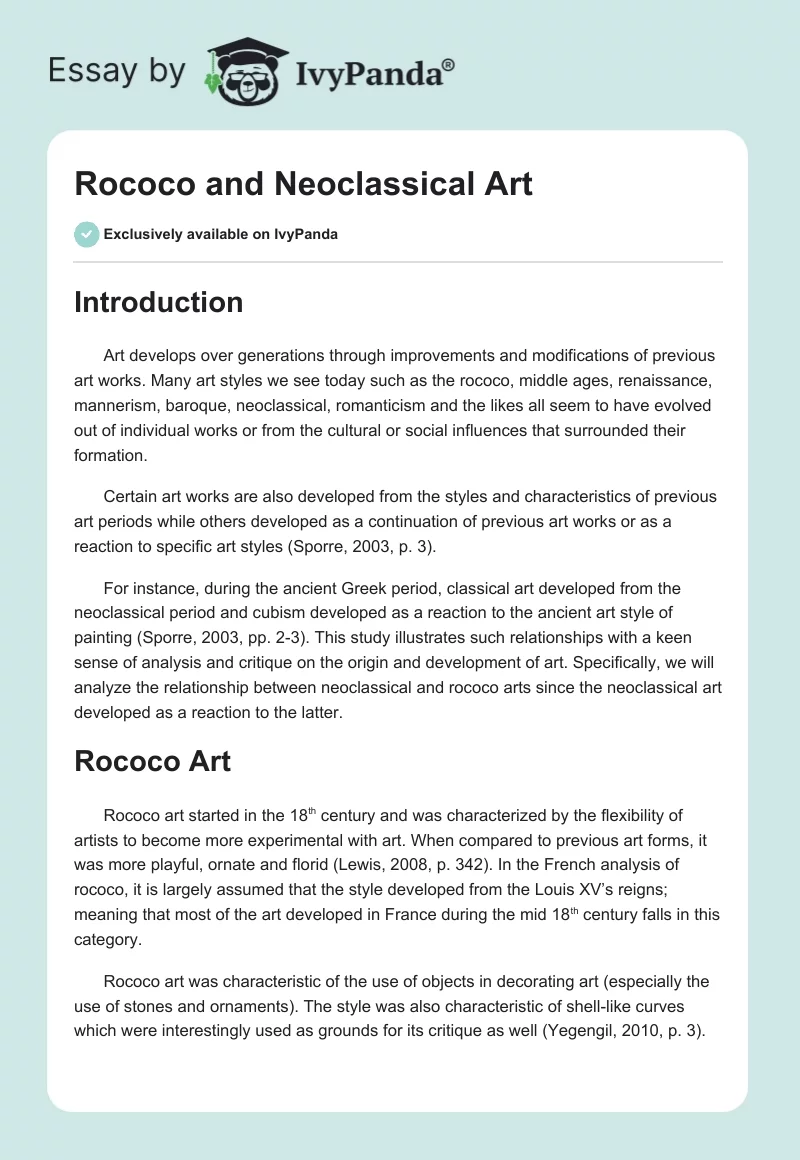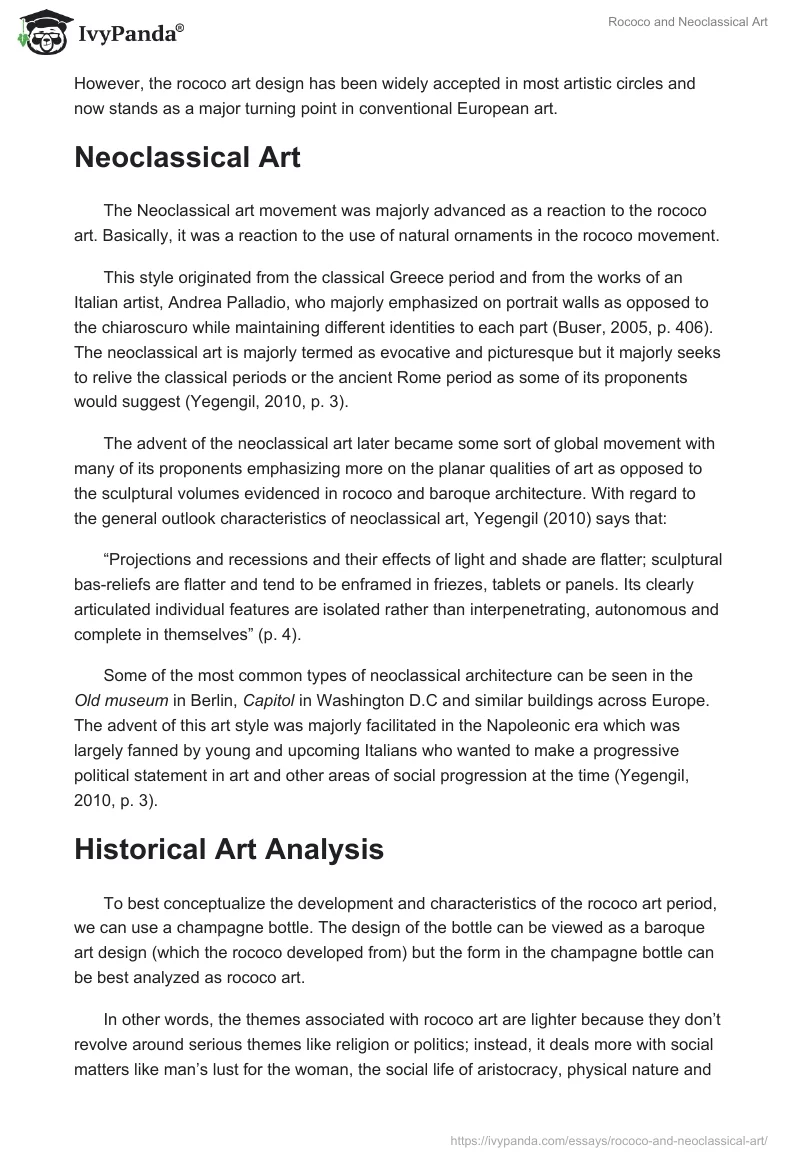Introduction
Art develops over generations through improvements and modifications of previous art works. Many art styles we see today such as the rococo, middle ages, renaissance, mannerism, baroque, neoclassical, romanticism and the likes all seem to have evolved out of individual works or from the cultural or social influences that surrounded their formation.
Certain art works are also developed from the styles and characteristics of previous art periods while others developed as a continuation of previous art works or as a reaction to specific art styles (Sporre, 2003, p. 3).
For instance, during the ancient Greek period, classical art developed from the neoclassical period and cubism developed as a reaction to the ancient art style of painting (Sporre, 2003, pp. 2-3). This study illustrates such relationships with a keen sense of analysis and critique on the origin and development of art. Specifically, we will analyze the relationship between neoclassical and rococo arts since the neoclassical art developed as a reaction to the latter.
Rococo Art
Rococo art started in the 18th century and was characterized by the flexibility of artists to become more experimental with art. When compared to previous art forms, it was more playful, ornate and florid (Lewis, 2008, p. 342). In the French analysis of rococo, it is largely assumed that the style developed from the Louis XV’s reigns; meaning that most of the art developed in France during the mid 18th century falls in this category.
Rococo art was characteristic of the use of objects in decorating art (especially the use of stones and ornaments). The style was also characteristic of shell-like curves which were interestingly used as grounds for its critique as well (Yegengil, 2010, p. 3). However, the rococo art design has been widely accepted in most artistic circles and now stands as a major turning point in conventional European art.
Neoclassical Art
The Neoclassical art movement was majorly advanced as a reaction to the rococo art. Basically, it was a reaction to the use of natural ornaments in the rococo movement.
This style originated from the classical Greece period and from the works of an Italian artist, Andrea Palladio, who majorly emphasized on portrait walls as opposed to the chiaroscuro while maintaining different identities to each part (Buser, 2005, p. 406). The neoclassical art is majorly termed as evocative and picturesque but it majorly seeks to relive the classical periods or the ancient Rome period as some of its proponents would suggest (Yegengil, 2010, p. 3).
The advent of the neoclassical art later became some sort of global movement with many of its proponents emphasizing more on the planar qualities of art as opposed to the sculptural volumes evidenced in rococo and baroque architecture. With regard to the general outlook characteristics of neoclassical art, Yegengil (2010) says that:
“Projections and recessions and their effects of light and shade are flatter; sculptural bas-reliefs are flatter and tend to be enframed in friezes, tablets or panels. Its clearly articulated individual features are isolated rather than interpenetrating, autonomous and complete in themselves” (p. 4).
Some of the most common types of neoclassical architecture can be seen in the Old museum in Berlin, Capitol in Washington D.C and similar buildings across Europe. The advent of this art style was majorly facilitated in the Napoleonic era which was largely fanned by young and upcoming Italians who wanted to make a progressive political statement in art and other areas of social progression at the time (Yegengil, 2010, p. 3).
Historical Art Analysis
To best conceptualize the development and characteristics of the rococo art period, we can use a champagne bottle. The design of the bottle can be viewed as a baroque art design (which the rococo developed from) but the form in the champagne bottle can be best analyzed as rococo art.
In other words, the themes associated with rococo art are lighter because they don’t revolve around serious themes like religion or politics; instead, it deals more with social matters like man’s lust for the woman, the social life of aristocracy, physical nature and the likes (Wilder, 2007, p. 27). Principally, this art style also revolves around asymmetry and also majorly includes the use of curved lines and ornaments which don’t emphasize the need for balance.
However with the advent of the neoclassical art period in the mid 18th century, balance and symmetry was emphasized as a reaction to rococo art designs. In other words, this art period emphasized more on technical art and balance, inspired by antiques derived from the Roman era. Since rococo art was also characteristic of pale colors, the neoclassic proponents emphasized more on sharp colors. This movement was later picked up in many fields such as music, visual arts, architecture and the likes.
There was a deep sense of Romanism during the development of this art style but the Roman inspiration was derived from the archeological studies that were going on during that period (Yegengil, 2010, p. 5). More specifically, the discovery of the antique ruins created an emphasis on the beauty of civilization and the successes associated with Greeks and Romans; with regard to the development of their empires.
This fact totally changed the perception of art during that time because there was a shift in emphasis from the natural forms of art (rococo art) to classical antique (Yegengil, 2010, p. 5). Comparatively, the rococo art period was much more inspired by nature, personal amusement, and the physical world. Also in drawing more comparison, the rococo period was facilitated by the death of Louis XIV, from whom the baroque art derived its principles from.
Its prominence was also facilitated by the rise of the middle class and the increased consciousness of fashion in the French capital, Paris (Yegengil, 2010, p. 6). It is therefore clear that the advent of the rococo art was a major shift from the emphasis of fear and respect which was advanced by the baroque art to more relaxed forms of art. In other words, it focused on the lighter elements of life, like pleasure and nature.
On the other hand, the neo classic proponents were majorly inspired by the simplicity of certain figures in the roman and Greek empires and this was later followed by a high appreciation of Greek democracy (Buser, 2005, p. 406).
The importance of the neoclassical art in the real world was seen from its wide use in the French empire by the napoleon regime which sought to stamp its superiority by using the art style to paint heroic figures. In this manner, the neoclassic art style majorly revolves around themes such as heroism, justice, courage honor and other virtues associated with democratic leadership and hierarchical structures (Yegengil, 2010, p. 6).
The Rococo art on the other hand had a huge bearing on the interior design of arts and the development of sculptures and paintings; it was also largely associated with the regime of King Louis XV. Its major impact in the art world was that it developed pieces of art which appealed more to the senses as opposed to the intellect.
Conclusion
The neoclassical art can be seen to react to the lack of emphasis on order and restraint by the rococo art. Rococo art on the other hand seems to emphasize more on natural beauty and the appeal to human senses as opposed to the intellectual appeal of neoclassical art. Neoclassical art was also greatly inspired by antiques of the Roman Empire but rococo art was facilitated by the death of King Louis XIV.
Both art styles had a lot of influence on European literature of the 18th century because the neoclassical art portrayed political truths in a comical manner and rococo art instilled a need to decorate art in a fluffier manner.
References
Buser, T. (2005). Experiencing Art around Us. London: Cengage Learning.
Lewis, R. (2008). The Power of Art. London: Cengage Learning.
Sporre, D, J. (2003). Perceiving the Arts: An Introduction to the Humanities. New Jersey: Prentice Hall.
Wilder, J. B. (2007). Art History for Dummies. New York: For Dummies.
Yegengil, O. (2010). Neoclassical and Rococo Styles after Baroque Period. Web.


